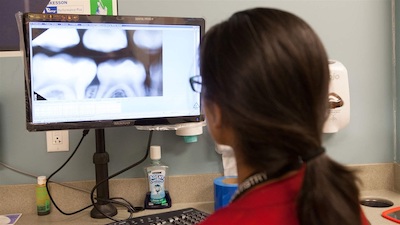
New model legislation for authorizing the work of dental therapists could lead to more uniformity among state and tribal laws governing how much education these providers should receive and how they should be allowed to practice.
An expert panel of dental educators and leaders, funded in part by Pew, began working in the summer of 2018 on model legislation to serve as a guide for policymakers.
“This model act provides the evidence-based guidance states need to develop licensing laws that protect the safety of patients without unnecessarily driving up the cost of care and inhibiting access for the underserved,” said Jean Moore, director of the Center for Health Workforce Studies in Rensselaer, New York, and a consortium member.
Dental therapists have been authorized to practice in eight states, and at least a dozen more are considering legislation. Expanding their ability to practice would help boost access to quality dental care, especially in areas with shortages of dentists. The therapists typically provide preventive and routine restorative care, such as filling cavities, placing temporary crowns, and extracting severely diseased or loose teeth—always under the supervision of a dentist.
State and tribal rules differ on the length of dental therapy education, the level of dentist supervision, and the array of procedures that dental therapists can provide. In some instances, these rules run counter to what research and practice experience suggest.
Members of the panel crafting the model proposal had concerns about the length of time required for training and education costs. Overly restrictive supervision requirements increase the cost of care and impede efforts to extend access to community locations if they mandate that dental therapists work alongside a dentist. And varying credentialing standards make it difficult for dental therapists to practice in different states.
Policymakers in statehouses that are considering dental therapy legislation must consider such inconsistencies, especially when setting education and supervision requirements. How much is enough to ensure quality and safety while achieving the goal of increased access to dental care?
To answer these questions, the panel turned to a growing base of research on the experience of dental therapists practicing in the United States and abroad. It also reviewed the dental therapy educational standards adopted in 2015 by the American Dental Association’s Commission on Dental Accreditation (CODA), the nation’s sole accreditor of dental education programs.
Among its provisions, the model law says that:
- Educational programs must be accredited by CODA or approved by the state dental board.
- Dental therapy education programs must offer a minimum of three academic years to allow students to master about one-fourth of the scope of practice of a dentist, an approach that follows the CODA guidelines. As with the accreditation standards, the language is silent on degree level, which each educational program could determine.
- Dentists must supervise dental therapists under the terms of a written management agreement.Therapists would be allowed to work under “general” supervision, treating patients without the presence of a dentist to the extent authorized by the supervising dentist.
- Dental therapists are not required to be credentialed as dental hygienists.
“Institutions of higher education should have the freedom to develop a variety of programs, students should have the freedom to choose the credential that best meets their goals, and employers should be able to determine the type of education and training that best meets their practices’ needs,” said Colleen Brickle, a panel member who runs a Minnesota dental therapy training program. The program, jointly operated by Normandale Community College and Metropolitan State University, offers a master’s degree in dental therapy to credentialed hygienists.
“The CODA educational standards for dental therapy education should now be seen as the gold standard in the U.S.,” added Mary Williard, a panel member and head of the Alaska Dental Therapy Educational Program. Ilisagvik College, which hosts the program, is the first dental therapy training program to apply for CODA accreditation.
The expert panel included dental school leaders, a state dental board director, dental employers, researchers, dental therapy and hygiene educators, and state government and tribal leaders.
Jane Koppelman directs the research portfolio for The Pew Charitable Trusts’ dental campaign.
